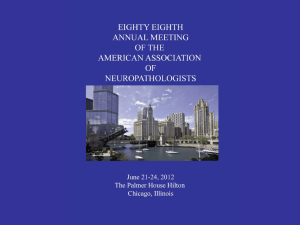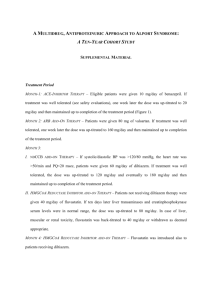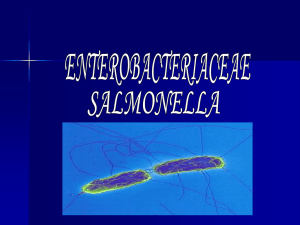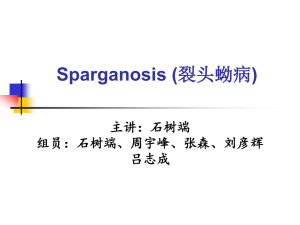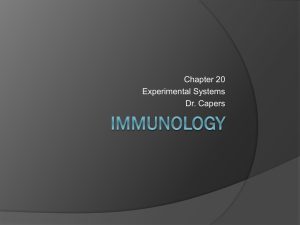IgG4: THE BEST IMMUNOGLOBULIN TO DIAGNOSIS OF
advertisement
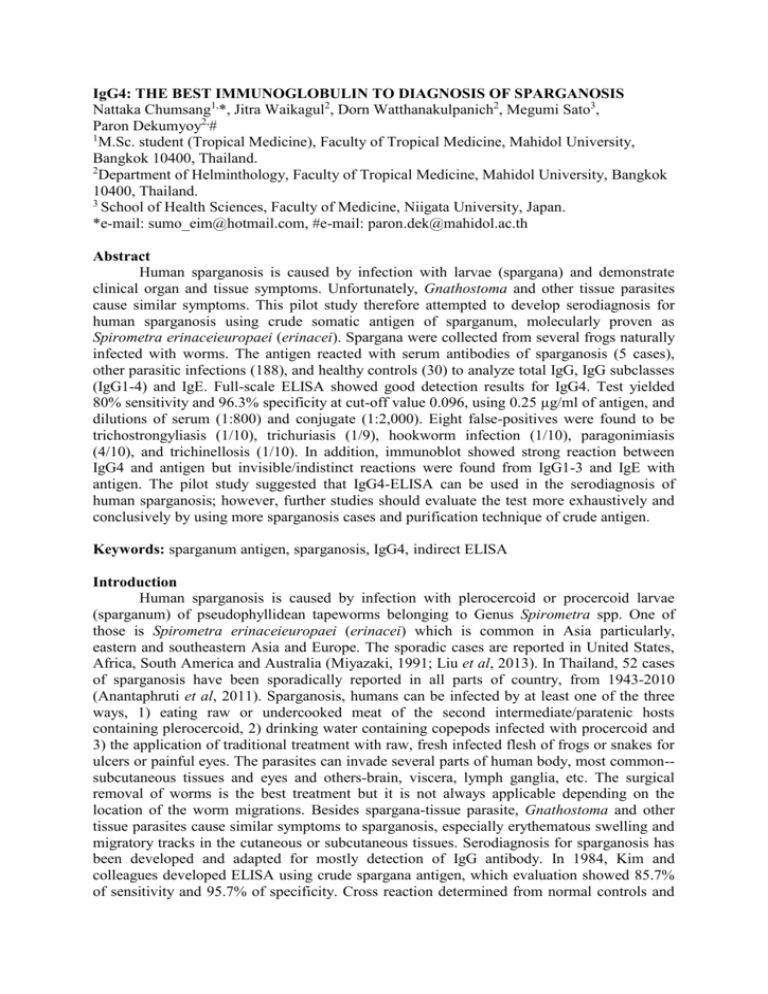
IgG4: THE BEST IMMUNOGLOBULIN TO DIAGNOSIS OF SPARGANOSIS Nattaka Chumsang1,*, Jitra Waikagul2, Dorn Watthanakulpanich2, Megumi Sato3, Paron Dekumyoy2,# 1 M.Sc. student (Tropical Medicine), Faculty of Tropical Medicine, Mahidol University, Bangkok 10400, Thailand. 2 Department of Helminthology, Faculty of Tropical Medicine, Mahidol University, Bangkok 10400, Thailand. 3 School of Health Sciences, Faculty of Medicine, Niigata University, Japan. *e-mail: sumo_eim@hotmail.com, #e-mail: paron.dek@mahidol.ac.th Abstract Human sparganosis is caused by infection with larvae (spargana) and demonstrate clinical organ and tissue symptoms. Unfortunately, Gnathostoma and other tissue parasites cause similar symptoms. This pilot study therefore attempted to develop serodiagnosis for human sparganosis using crude somatic antigen of sparganum, molecularly proven as Spirometra erinaceieuropaei (erinacei). Spargana were collected from several frogs naturally infected with worms. The antigen reacted with serum antibodies of sparganosis (5 cases), other parasitic infections (188), and healthy controls (30) to analyze total IgG, IgG subclasses (IgG1-4) and IgE. Full-scale ELISA showed good detection results for IgG4. Test yielded 80% sensitivity and 96.3% specificity at cut-off value 0.096, using 0.25 µg/ml of antigen, and dilutions of serum (1:800) and conjugate (1:2,000). Eight false-positives were found to be trichostrongyliasis (1/10), trichuriasis (1/9), hookworm infection (1/10), paragonimiasis (4/10), and trichinellosis (1/10). In addition, immunoblot showed strong reaction between IgG4 and antigen but invisible/indistinct reactions were found from IgG1-3 and IgE with antigen. The pilot study suggested that IgG4-ELISA can be used in the serodiagnosis of human sparganosis; however, further studies should evaluate the test more exhaustively and conclusively by using more sparganosis cases and purification technique of crude antigen. Keywords: sparganum antigen, sparganosis, IgG4, indirect ELISA Introduction Human sparganosis is caused by infection with plerocercoid or procercoid larvae (sparganum) of pseudophyllidean tapeworms belonging to Genus Spirometra spp. One of those is Spirometra erinaceieuropaei (erinacei) which is common in Asia particularly, eastern and southeastern Asia and Europe. The sporadic cases are reported in United States, Africa, South America and Australia (Miyazaki, 1991; Liu et al, 2013). In Thailand, 52 cases of sparganosis have been sporadically reported in all parts of country, from 1943-2010 (Anantaphruti et al, 2011). Sparganosis, humans can be infected by at least one of the three ways, 1) eating raw or undercooked meat of the second intermediate/paratenic hosts containing plerocercoid, 2) drinking water containing copepods infected with procercoid and 3) the application of traditional treatment with raw, fresh infected flesh of frogs or snakes for ulcers or painful eyes. The parasites can invade several parts of human body, most common-subcutaneous tissues and eyes and others-brain, viscera, lymph ganglia, etc. The surgical removal of worms is the best treatment but it is not always applicable depending on the location of the worm migrations. Besides spargana-tissue parasite, Gnathostoma and other tissue parasites cause similar symptoms to sparganosis, especially erythematous swelling and migratory tracks in the cutaneous or subcutaneous tissues. Serodiagnosis for sparganosis has been developed and adapted for mostly detection of IgG antibody. In 1984, Kim and colleagues developed ELISA using crude spargana antigen, which evaluation showed 85.7% of sensitivity and 95.7% of specificity. Cross reaction determined from normal controls and only four diseases and occurred with some of saginata taeniasis sera. Crude antigens and partially purified antigens from spargana still demonstrate cross-reaction with other different diseases when mostly, IgG antibody detected (Choi et al, 1988; Kong et al, 1994; Park et al, 2001; Cui et al 2011). However, those studies analyse the antigens with few diseases for cross reactivity. Therefore, this study on diagnosis of sparganosis attempted to develop ELISA using crude sparganum antigen in detection of IgG, IgG1-4, including IgE to this tissue parasite. Also, cross-reaction was determined by several different parasitic infections and healthy controls. Materials and Methods Parasite collection Several naturally infected frogs were purchased from local markets in LAO PDR. Spargana (plerocercoid larvae) were collected and washed with normal saline solution (NSS), 3 times and finally washed with distilled water (DW). Larvae were kept at -70 °C at the Department of Helminthology, Faculty of Tropical Medicine, Mahidol University. The spargana samples were molecularly identified as Spirometra erinaceieuropaei (erinacei) by Asst.Prof. Megumi Sato. Preparation of antigen Crude somatic antigens were prepared from frozen larvae following the procedure by Chung et al, (2000) with some modifications. Briefly, larvae were ground in DW using a pestle and a motar in cold condition with ice. The homogenate of parasite was sonicated by ultrasonicator (Ultrasonic Processor XL, CT, USA) at 1-min intervals for 5 min. The suspension was centrifuged at 15,000g for 1 hr (AvantiTM30 centrifuge, BECKMAN) and the supernatant was collected and used as crude somatic antigen. Serum sample Serum samples were obtained from the Department of Helminthology, Faculty of Tropical Medicine, Mahidol University. Serum samples comprised with 5 sparganaconfirmed sera, 30 from healthy individuals and 188 with other parasitic infections, identified by detection of parasites agents; strongyloidiasis, hookworm infection, capillariasis, ascariasis, trichuriasis, bancroftian filariasis, brugian filariasis, dirofilariasis, trichostrongyliasis, taeniasis, hymenolepiasis nana, opisthorchiasis, paragonimiasis heterotremus, haplorchiasis, entamoebiasis, giardiasis, Blastocystis hominis infection, and malaria; by detection of parasites agents and serodiagnosis; gnathostomiasis, trichinellosis, angiostrongyliasis, cysticercosis, echinococcosis, schistosomiasis, fascioliasis, and clinical features of creeping eruption. Only 2 diseases were identified by antibody detection; toxocariasis and toxoplasmosis. Each serum sample was stored at -70ºC until used. Enzyme-linked immunosorbent assay (ELISA) The ELISA was performed in microtiter plates as described by Dekumyoy et al (1998). All ELISA conditions were provided by the checkerboard titration and only detections of IgG and IgG4 were further analyzed because IgG1-3 and IgE could not present a good checkerboard titration conditions (see also detection of these immunoglobulins by immunoblot). The ELISA procedure, 50 µl of antigen dilutions (0.4 µg/ml for IgG , 0.25 µg/ml for IgG4, in carbonate-bicarbonate buffer) were incubated in a microtiter plate (Nunc, Denmark) at 37ºC, and overnight at 4ºC. The unbound sites of the wells were coated with 3% skim milk (PBS, pH 7.4 - sodium azide, 0.02%). The diluted serum samples (1:800 for both IgG and IgG4) were prepared by diluents (washing solution-T-PBS containing 0.02% NaN30.2% bromphenol blue solution), and then t h e a n t i g e n - a n t i b o d y c o m p l e x e s w e r e treated with diluted conjugate s (1:2,000, horseradish peroxidase-labeled antihuman IgG and IgG4, Southern Biotech, USA). The reaction was visualized with substrate [(2, 2-azino-dis-(3-ethyl-benzothiazoline-6-sulfonate)], and stopped reaction with 1% SDS. The OD values were determined at 405 nm using a spectrophotometer (Titertek Multiskan® PLUS, Labsystems, Findland). In this study, checkerboard titrations of those IgG1-3 and IgE did not show good conditions between positive and negative controls. An immunoblot analysis was done by following the procedure; separated 30 µg antigen/well (5 mm-well) of SDS-PAGE, then, the fractionated antigens in an electrophoresed gel were electrotransferred onto nitrocellulose sheet (0.45µm, PALL, Pall Corporation, USA) by Semi-dry transfer cell (ATTO, Japan). The blot was treated with 3% skim milk-0.02% sodium azide-PBS pH 7.4 and six small strips were treated with positively diluted serum (1:100, by 0.02% NaN3-Tween20-PBS). The strips were individually exposed by diluted peroxidase conjugates with T-PBS (1:1,000, total IgG, IgG1-4 and IgE). Finally, substrate solution (2, 6-dichlorophenol indophenol) was poured on the strips for 2-3 min. The reaction was stopped by washing the strips with distilled water. Ethics statement This study was protocol was approved by the Scientific Ethics Committee of Mahidol University, MUTM 2012-040-01. Result Due to IgG1-3 and IgE were not further analyzed in full scale ELISA because of unsatisfied results of checkerboard titration. Therefore, an observation of immunoblot was done by reaction of the antigen and pooled positive serum (1:100) and encountered with individual conjugates (1:1,000). It was found that IgG4 resulted many reactively strong bands meanwhile IgG showed weaker reaction than IgG4 and also mostly different MWs. It was not surprised in results of checkerboard titration of IgG1, IgG2, IgG3 and IgE because reactions did not detect any bands or probably indistinct bands (Fig. 1). This encouraged the further reactions of ELISA with IgG and IgG4. Figure 1 Demonstration of immunoblot on observation of immunoglobulin antibodies, IgG, IgG1-4 and IgE to immune complexes of sparganum antigen and pooled sparganosis serum. M = Low molecular weight of protein standard markers, Conjugates; a = IgG, b-e = IgG1-4 and f = IgE The IgG-ELISA determined all serum samples above and showed 80% of sensitivity and 95.4% of specificity at the cut-off value, 0.502 (mean +2 SD). Ten false-positives were from cysticercosis (4/10), angiostrongyliasis (1/10), toxocariasis (1/10), gnathostomiasis (1/10), paragonimiasis (1/10), creeping eruption (1/2/1/3), dirofilariasis (1/2) and 1 falsenegative. Seven diseases produced cross-reaction in detection of IgG using crude sparganum antigen. This crude antigen was not immunogenic to IgG antibodies of all protozoan infections and fifteen helminthic infections including normal controls when IgG detected (Fig. 2 and Table 1). Figure 2 Scatter patterns of ELISA-OD values of sparganosis cases, other parasitic infections and negative serum controls, reacted with IgG antibody. Detection of IgG4 yielded 80% of sensitivity and 96.3% of specificity at the cut-off value, 0.096 (mean +1SD). This immunoglobulin on cross-reactivity gave lower numbers of cases and diseases than those of IgG antibody. Eight false-positives from five diseases were found as follows; trichuriasis (1/9), trichostrongyliasis (1/10), hookworm infection (1/10), paragonimiasis (4/10), trichinellosis (1/10) and 1 false-negative case occurred. This false negative gave quite low ELISA-OD value of IgG4 antibody, which is the same case of total IgG analysis. Cross-reaction in this test demonstrated different helminthic infections from those of IgG analysis except paragonimiasis. In contrast, cysticercosis gave 4 false-positives to detect IgG but did not show false-positive to IgG4. Controversial, the antigen was immunogenic to IgG antibodies to Paragonimus worms due to numbers of cross-reaction increased from one to four cases. Most of false positive cases gave OD-values far from those of their groups. Crude somatic antigen reacted with some of nematodes and trematode infections, not with cestode infections (Fig.3). Figure 3 Scatter patterns of ELISA-OD values of sparganosis cases, other parasitic infections and negative serum controls, reacted with IgG4 antibody. Table 1 Comparison of ELISA positivity derived from reactions between sparganum antigen and all serum samples in detection of IgG and IgG4 antibodies. Disease/sample No. Sparganosis Angiostrongyliasis Ascariasis Bancroftian filariasis Brugian filariasis Capillariasis Dirofilariasis Gnathostomiasis Hookworm infection Strongyloidiasis Toxocariasis Trichinellosis Trichostrongyliasis Trichuriasis Echinococcosis Hymenolepiasis nana Cysticercosis Taeniasis saginata Haplorchiasis Fascioliasis hepatica 5 10 7 10 10 3 2 10 10 10 10 10 10 9 3 5 10 10 10 3 Pos. 4 1 1 1 1 4 - IgG Neg. 1 9 7 10 10 3 1 9 10 10 9 10 10 9 3 5 6 10 10 3 % pos. 80 10 0 0 0 0 50 10 0 0 0 0 0 0 0 40 0 0 0 Pos. 4 1 1 1 1 - IgG4 Neg. 1 10 7 10 10 3 2 10 9 10 10 9 9 8 3 5 15 11 10 3 % pos. 80 0 0 0 0 0 0 0 10 0 0 10 10 11.1 0 0 0 0 0 0 Opisthorchiasis Paragonimiasis heterotremus Creeping eruption Amoebiasis Blastocystis hominis infection Giardiasis Malaria Toxoplasmosis Normal controls 9 10 1 9 9 0 10 4 9 6 0 40 3 4 3 1 - 2 4 3 0 0 - 2 4 3 0 0 0 3 2 2 30 - 3 2 2 30 0 0 0 0 - 3 2 2 30 0 0 0 0 Discussion Total IgG is the common immunoglobulin to be studied in finding a based line data and also development of serodiagnosis. In this study, IgG performs in a good result of indirect ELISA with 80% of sensitivity and 95.4% of specificity. Unfortunately, our study could obtain only 5 spargana-confirmed cases. However, several other parasitic diseases and detection of IgG1-4 were included in this sero-analysis using crude somatic antigen. Specificity of this IgG-ELISA, ten false-positives are found from seven diseases; cysticercosis (4/10) gives 40% cross-reactivity to detection of IgG. Moreover, creeping eruption and dirofilariasis were available in each two cases only. If more cases are analyzed by crude antigen, more false positive cases may be high due to helminthes have complex structures therefore, crude somatic antigen always contain various cross-reactive molecules. Four cases of cysticercosis cross-react with sparganum crude antigen, which this disease is caused by cestode worm as sparganosis. This may be co-infection with sparganum because most of false positives produce high ELISA-OD values far searated from those of their groups. In addition, high antibody levels of these cases cross-react with the antigen. It differs from one false positive from toxocariasis, which may be happened by high antibodies to Toxocara parasite because ELISA-OD values of toxocariasis cases continuously run in a line. However, it cannot omit mixed infection with sparganum. Analysis of the antigen by IgG4, 80% of sensitivity and 96.3% of specificity were determined. Eight false-positives were found and alternatively, four of paragonimiasis cases produced 40% of cross-reactivity increasing from one case. In this study, antibodies from each one of nematode infections and four from paragonimiasis cross-react with the antigen but cestode infections do not react with the antigen. For immunoglobulin subclasses, IgG4 gives the best immunoglobulin among 4 subclasses to sparganosis analysis. In the study, the false negative case ocurrs in the detection of IgG and IgG4. This serum sample belongs to the same patient who was a small female child at the time of collection. Therefore, this case may have low antibody by herself because of antibody response based on age dependence. Other researches on sparganosis in detection of IgG, crude antigen and purified antigen by gelatin-affinity chromatography show some cross-reactions with other parasitic infections by indicating with specificities, 89% and 95.6%, respectively. However, 92.6% of sensitivity produced in both antigens with a total of 27 sparganosis cases (Kong et al, 1991). Cho et al (1990) produced three kinds of Spirometra mansoni sparganum antigen by simple extraction, gel filtration using SephacrylS-300 column chromatography and monoclonal antibody affinity chromatography. Sensitivities of three kinds of antigens were 96.4%. Specificity of ELISA using mAb-purified antigen showed a highest value at 97%, produced from 7 different diseases. Cui et al (2011) demonstrated cross-reactivity between crude antigen from Spirometra mansoni spargana and IgG antibodies of cysticercosis (3/11), echinococcosis (5/10) and paragonimiasis (9/20) by indirect ELISA. All above indicates that cross-reaction is mainly found from antibodies with crude sparganum antigens and also partially purified and purified antigens. The pilot study suggested that IgG4-ELISA can be used in the serodiagnosis of human sparganosis; however, further studies should evaluate the test more exhaustively and conclusively. Reference 1. Anantaphruti MT, Nawa Y, Vanvanitchai Y. Human sparganosis in Thailand: An overview. Acta Trop 2011; 118(3): 171-6. 2. Cho SY, Kang SY, Kong Y. Purification of antigenic protein of sparganum by immunoaffinity chromatography using a monoclonal antibody.Korean J Parasitol 1990;28(3):135-42. 3. Chung YB, Kong Y, Yang HJ, Cho SY. IgG antibody responses in early experimental sparganosis and IgG subclass responses in human sparganosis. Korean J Parasitol 2000; 38(3): 145-50. 4. Cui J, Li N, Wang ZQ, Jiang P, Lin XM. Serodiagnosis of experimental sparganum infections of mice and human sparganosis by ELISA using ES antigens of Spirometra mansoni spargana. Parasitol Res 2010; 108(6): 1551-6. 5. Dekumyoy P, Waikagul J, Eom KS. Human lung fluke Paragonimus heterotremus: differential diagnosis between Paragonimus heterotremus and Paragonimus westermani infections by EITB. Trop Med Int Health 1998; 3(1): 52-6. 6. Iwatani K, Kubota I, HirotsuY, Wakimoto J, Yoshioka M, Mori T, et al. Sparganum mansoni parasitic infection in the lung showing a nodule. Pathol Int 2006; 56(11): 674-7. 7. Kim H, Kim SI, Cho HY. Serological Diagnosis of human sparganosis By Means of Micro-ELISA. Kisaengchunghak Chapchi 1984; 22(2): 222-8. 8. Kong Y, Kang SY, Cho SY. Single step purification of potent antigenic protein from sparganum by gelatinaffinity chromatography.Korean J Parasitol 1991; 29(1): 1-7. 9. Liu D, Chen, J, Fang W. Spirometra. Molecular Detection of Human Parasitic Pathogens, edited by Dongyou Liu, CRC Press, © 2013, Taylor & Francis Group, Boca Raton, FL, USA, pp 871. 10. Miyazaki I. An illustrated book of Helminthic zoonoses. Tokyo: International medical foundation of Japan;1991. 11. Park HY, Lee SU, Kim SH, Huh S, Yang YS, Kong Y. Epidemiological significance of sero-positive inhabitants against sparganum in Kangwon-do, Korea.Yonsei Med J 2001; 42(4): 371-374. 12. Wiwanitkit V. A review of human sparganosis in Thailand. Int J Infect Dis 2005; 9(6): 312-6. 13. Yun DH, Bae YA, Chung JY,Kang SY, Kang I, Sohn WM, et al.A 78 kDa glucose- regulated protein gene of Spirometra erinacei plerocercoid induced by chemical and physiological stresses. Parasitology 2004; 129(Pt 6): 713-21. Acknowledgements The authors would like to thank the staff of the Department of Helminthology, Faculty of Tropical Medicine, Mahidol University, Thailand, and the Immuno-diagnostic Unit for Helminthic Infections, Department of Helminthology, provided partial financial support of this study.
